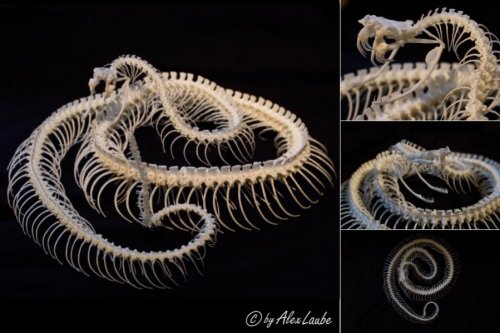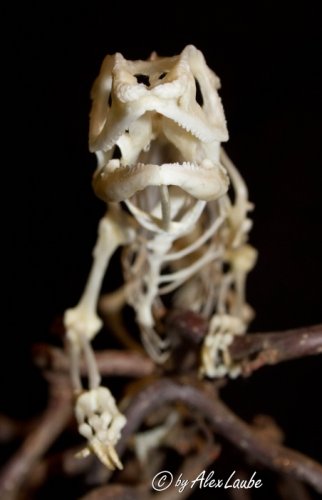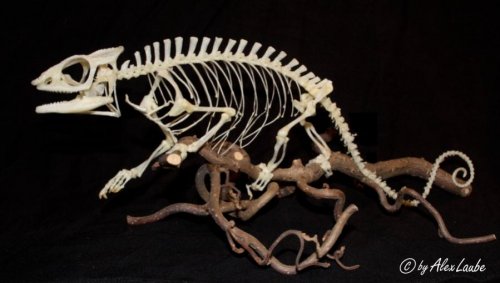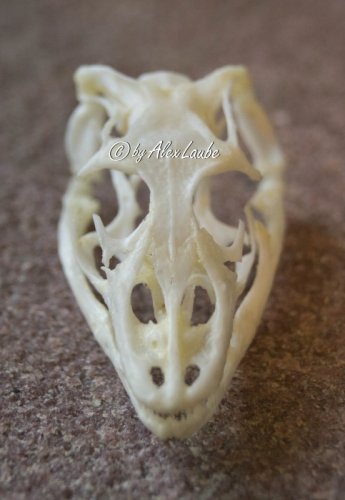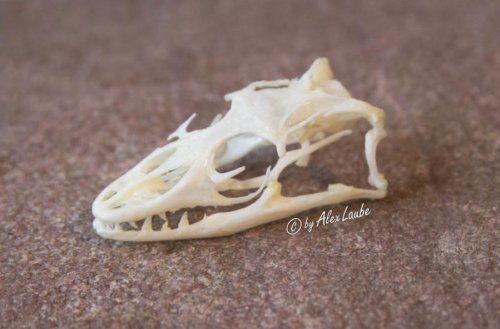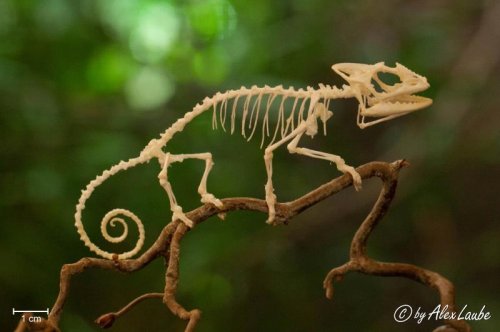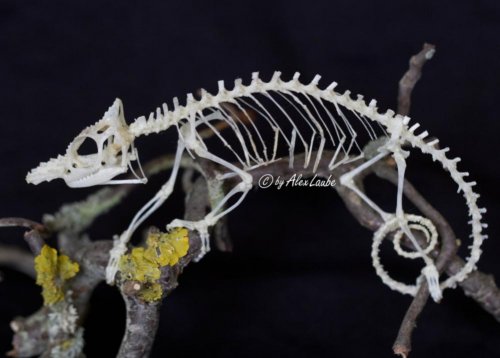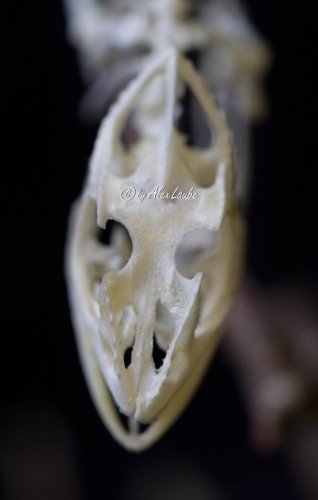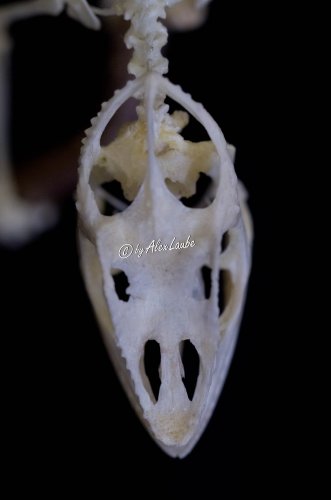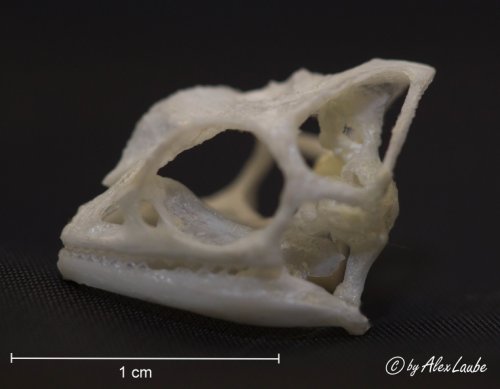Navigation
Install the app
How to install the app on iOS
Follow along with the video below to see how to install our site as a web app on your home screen.
Note: This feature may not be available in some browsers.
More options
You are using an out of date browser. It may not display this or other websites correctly.
You should upgrade or use an alternative browser.
You should upgrade or use an alternative browser.
Chameleon skeletons
- Thread starter Alexl
- Start date
Alexl
Avid Member
This is an old Furcifer pardalis male. Due to somewhat insufficient UVB exposure and supplementing he had a weakened bone structure. You can't see any deformation yet (and the owner didn't during whole lifetime), but the bones aren't properly calcificated as they should be in an adult chameleon. That's why his bones look a bit yellowish or limpidly in some parts. The chameleon had some UVB and not half bad supplementation, but it was not sufficient. Remember: Not seeing a lack of calcium or vitamin D3 with the naked eye does not absolutely mean everything's alright with your chameleon. Better check your lights via solarmeter (up to date 6.5 is the most favorable to use in my opinion) and let your reptile vet check supplementation with vitamins and calcium.
And for David a varanus skull . I'm curious if anyone will recognize correct species.
. I'm curious if anyone will recognize correct species.
And for David a varanus skull
Attachments
Necrocopophagia
New Member
Ah! Very interesting to see these wonderful creatures post mortem, how did you ever acheive this wonderful, macabre display of thier anatomy, great specimens by the way  i do wish these chameleons lived a healthy life and did not reach an ignominious end. Cheers!
i do wish these chameleons lived a healthy life and did not reach an ignominious end. Cheers!
pepezkakap
Member
I am still fascinated by your work. Still want to get your piece of art one day 
Alexl
Avid Member
Little update today. This is a Furcifer pardalis male, approximately only three month old. Unfortunately he lost some ribs and the breast bone during preparation, cause the bones and cartilages are really soft yet in such a young chameleon. Note the big "hole" in the frontal bone over his eyes, that's normal in young Furcifer pardalis. The bone grows slowely and surrounds the eye socket completely in adults. See these pictures from a full grown male to compare. I'll upload another picture from a six month old male perhaps later.
Attachments
Alexl
Avid Member
Good evening everyone, hope there's still something new to find out in such a long lasting thread for you  . Today I'm going to upload a picture of a male Kinyongia boehmei. He's definitely on my favourite chameleon skeletons' list. The skulls besides are from different Furcifer pardalis males (as promised before), three (on the left) and six months old (right side).
. Today I'm going to upload a picture of a male Kinyongia boehmei. He's definitely on my favourite chameleon skeletons' list. The skulls besides are from different Furcifer pardalis males (as promised before), three (on the left) and six months old (right side).
Attachments
StreetMoggy
New Member
These are amazing! Takes a lot of dedication to work with such delicate materials.
Very cool
Very cool
midcoastchameleon
New Member
midcoastchameleon
New Member
I take it you dont have much luck with keeping chameleons  but look at the great past time your misfortune has created...glass is half full, right
but look at the great past time your misfortune has created...glass is half full, right 
stephencartolano
Member
These are so rad, I saw some similar ones for sale on etsy, possibly you? Great work, seriously.. Have you ever tried making molds of some of the skulls? I'd buy a ton hahah
Alexl
Avid Member
I take it you dont have much luck with keeping chameleonsbut look at the great past time your misfortune has created...glass is half full, right

Well, I'm lucky to have healthy living chameleons between a half and six years old at home, too.
These are so rad, I saw some similar ones for sale on etsy, possibly you?
No, surely not me. I don't sell any of them for money.
Have you ever tried making molds of some of the skulls?
No, didn't ever think about yet... I'd have no idea how to do molds from those filigree skulls without damaging them. And a skull isn't a real beauty without its skeleton, is it?
sarahbrooke
New Member
this is so cool, I'm glad you decided to share! You've got a rather impressive collection
Tay And A
Member
This is a really severe case of metabolic bone disease in a Furcifer pardalis male . He was under therapy for weeks (that's why his bones began to heal), but finally his organs were already too damaged to save him.I only prepared this skeleton as an example for patient owners to learn from...
To sum up the problems you can see in the pictures: His jaws are deformed, teeth are partially absent (especially in the front), every single rib was broken earlier and deformed, even his hyoid apparatus and some fingers are warped compared to healthy chameleons. His spine has several old fractures, some vertebrae are completely out of place (and yes, he could still walk around, only a part of his tail hardly moved). His shoulders and hips are bent down like a sickle, forearms and thighs look as someone had folded them like paper (old fractures and deformations). The breastbone has a hole and his eye socket isn't really round shaped.
Hope this little guy can make everyone think about importance of proper care, especially UVB-lightning and feeding supplements. And about what really happens to the skeleton if a chameleon had MBD. Sometimes it doesn't look that ugly outside, skin and muscle may cover first signs. And there are still owners who can't imagine MBD could be painful - think those pictures might convince them it is. Would be nice if people could see this before buying a chameleon without knowing how to care for.
I give you some pictures of a healthy Furcifer pardalis male to compare and make the deformations easier to recognize.
I've always been very curious as to how a person could know that their Cham has mbd? Now I know to look at the feet, and spine especially! This is a very amazing post! Thanks so much for taking the time not only to create these beauty's but also to post them on the forums!
Alexl
Avid Member
1) how'd you get started
Simply thought I should try with a chameleon what we've done with other pet skulls at university as students. It all began while learning for the anatomy exams... some years later a friend gave me his dead chameleon. And I had some free time in the evenings of a practical training in a foreign city, so I've tried to prepare my first skeleton. And luckily it worked.
and what do you do with them all
Over the half of the skeletons stay with friends of mine, e.g. the big Trioceros melleri (one of my absolute favourites), the Kinyongia tavetana, some Furcifer pardalis and Chamaeleo calyptratus, an Archaius tigris...didn't count them all. I only got about 25 chameleon skeletons at home. Some stay in the clinics sometimes to show them patient owners (MBD, hyoid apparatus problems... everything you can explain on a skeleton), some go to conferences, one stays in a museum (or should do somewhen, didn't ask again yet). And of cause I take a lot of pictures for this thread and some websites for chameleon keepers who can't come by and take a look personally
Simply thought I should try with a chameleon what we've done with other pet skulls at university as students. It all began while learning for the anatomy exams... some years later a friend gave me his dead chameleon. And I had some free time in the evenings of a practical training in a foreign city, so I've tried to prepare my first skeleton. And luckily it worked.
Over the half of the skeletons stay with friends of mine, e.g. the big Trioceros melleri (one of my absolute favourites), the Kinyongia tavetana, some Furcifer pardalis and Chamaeleo calyptratus, an Archaius tigris...didn't count them all. I only got about 25 chameleon skeletons at home. Some stay in the clinics sometimes to show them patient owners (MBD, hyoid apparatus problems... everything you can explain on a skeleton), some go to conferences, one stays in a museum (or should do somewhen, didn't ask again yet). And of cause I take a lot of pictures for this thread and some websites for chameleon keepers who can't come by and take a look personally.
Thanks for the reply. Vary cool I just had to ask. You deffenitly do something vary uneque and cool I can't believe you even have the patents to do it. So cool.
Similar threads
- Replies
- 0
- Views
- 257
- Replies
- 8
- Views
- 3K



